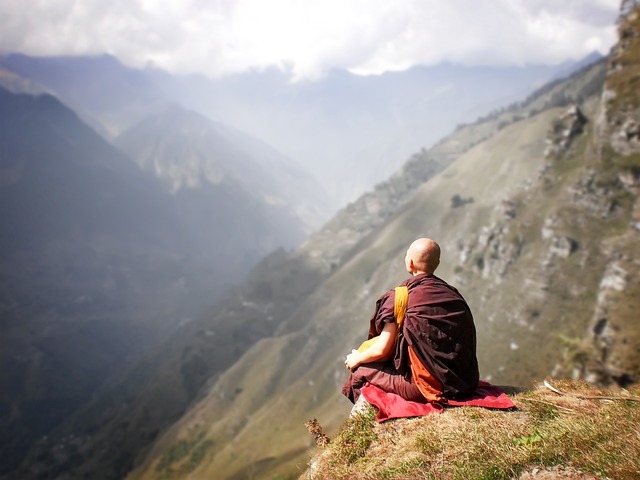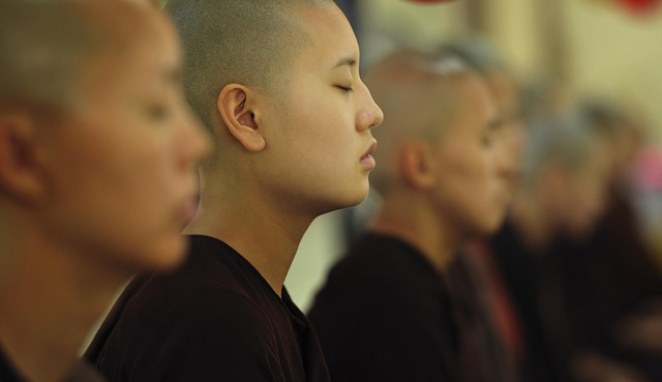Monks' meditation
On 2025-02-08 11:10:42,Posted in: Meditation
Monastic meditation has been an important part of various spiritual traditions and religions for centuries. The goal of meditation is to find inner peace, quiet the mind, achieve deeper self-knowledge, and connect with the transcendent. The practices come in many forms, depending on the culture or religious tradition they come from.

Praying monkThe basics of monastic meditation
The basics of monastic meditation are based on techniques and principles that help the practitioner achieve inner peace, deepen their spiritual connection, and develop self-knowledge. These basics may have different emphases in different religious and cultural traditions, but in many cases they contain common elements.

1. Establishing Silence and Calm
One of the first steps in meditation is to create a quiet, undisturbed environment. Silence can be external (eliminating noise) or internal (silencing thoughts).
Posture: Proper posture (such as sitting or kneeling) promotes concentration and mindfulness.
Breathing: Deep, calm breathing calms the body and mind and helps focus attention.
2. Developing Concentration
Monastic meditation is often built around a focal point, which can be:
- Breathing (such as following the rhythm of inhaling and exhaling).
- Repeating a mantra or sacred word.
- A symbol or image (such as a cross, a candle flame, or a statue of Buddha).
- Noticing bodily sensations or events in the present moment.
- Practicing concentration helps you get rid of distracting thoughts and leads you to deeper states of consciousness.
3. Mindfulness
Mindfulness is the unbiased observation of the present moment. This includes:
Observing feelings, thoughts, and sensations without judgment.
Accepting the flow of life, without attachment to the past or future.
4. Using a mantra or sacred word
In many monastic traditions, meditation involves repeating a mantra, prayer, or sacred word. This can help:
Focus attention.
Connect with the transcendent or God.
Achieve inner harmony and peace.
5. Reflection and contemplation
Meditation often involves focusing on a deeper understanding of a sacred text, teaching, or philosophical question. Examples:
Buddhist monks: Reflecting on the teachings of the dharma.
Christian monks: Contemplative reading of passages of Scripture (Lectio Divina).
6. Letting go
One of the most important and difficult principles is to let go of attachment to thoughts, feelings, and desires. This allows one to experience inner freedom and the spaciousness of awareness.
7. Goal: Spiritual connection and self-knowledge
The ultimate goal of meditation is spiritual self-realization or experiencing the presence of God, achieving liberation and inner peace. This does not simply mean achieving peace, but also a deeper inner transformation. You will feel inside how light your body and soul are and you can move on with a purified mind.
These foundations are present in almost all monastic meditation practices, although their emphasis and implementation may differ from culture to culture and tradition.
I will present a few specific meditation practices without claiming to be exhaustive.
 Buddhist Meditation:
Buddhist Meditation:
Vipassana: The word itself means "insight" or "deep insight" and aims to allow one to directly experience reality as it is.
The essence of Vipassana meditation: During the practice, one pays attention to one's bodily sensations, breathing, and states of mind, observing them without bias. In this way, one gradually frees oneself from mental habits that cause suffering, such as attachment and aversion.
The process of Vipassana meditation:
- Breathing (Anapanasati) – At the beginning of meditation, we observe the natural flow of breathing, which helps to deepen concentration.
- Awareness of body sensations – We pay attention to every small sensation in the body without judgment. We observe how they arise and pass away.
- Recognition of impermanence and change – The meditator deeply understands that everything is changing and impermanent (Aniccha), thus - frees from attachment.
- Observation of mental processes – Observing thoughts and emotions without identifying with them.
Benefits of Vipassana
✔ Mental clarity – Helps to let go of past hurts and anxieties.
✔ Calmness and balance – Reduces stress and develops self-control.
✔ Clearer vision – We can recognize our habits and subconscious patterns.
✔ Deeper understanding of ourselves – We will be able to better handle negative feelings and situations.
Metta (loving-kindness meditation): The practice of love and compassion for all living beings.
Metta Bhavana (short: Metta meditation) is an ancient Buddhist practice that is used to develop unconditional love, compassion and goodwill (Metta). It aims to gradually dissolve anger, fear and negative feelings while developing a deep inner peace and loving state of mind.
The Essence of Metta Meditation: During meditation, we send positive wishes first to ourselves, then to others, gradually extending this to the whole world. The practice helps to open the heart and strengthen our connection with others, while creating inner harmony.

Steps of Metta Meditation
Self-love: Sit comfortably, relax, and begin to send positive thoughts and wishes to yourself.
For example, you can repeat to yourself: “May I be happy. May I be healthy. May I be safe. May I be peaceful and free.”
Love directed towards a loved one: Think of someone close to you who is easy to love (a friend, family member, mentor).
Repeat: “May I be happy. May I be healthy. May I be safe. May I be peaceful and free.”
Love directed towards a neutral person: Think of someone you have neutral feelings towards (e.g. a stranger in the store or your neighbor).
Send them well wishes as well.
Love directed towards a difficult person: Think of someone you have had a conflict with or hold a grudge against. Try to transform your feelings towards them with loving thoughts.
Love directed towards the whole world: Finally, extend your love to all living beings. Imagine that the whole world is surrounded by love and peace.
Effects of Metta Meditation:
✅ Reduces anger and stress
✅ Develops compassion and forgiveness
✅ Strengthens inner peace and positive thinking
✅ Improves human relationships
With regular practice of Metta meditation, our hearts become more open and it becomes easier to have compassion and acceptance for others.
Effects of Meditation
Meditation practiced by monks helps: reduce stress, increase focus and mental clarity, spiritual development, and strengthen empathy and compassion.
If you are interested in a specific meditation practice, I am happy to share details or guided meditation techniques! Let me know in the comments and I will create one!